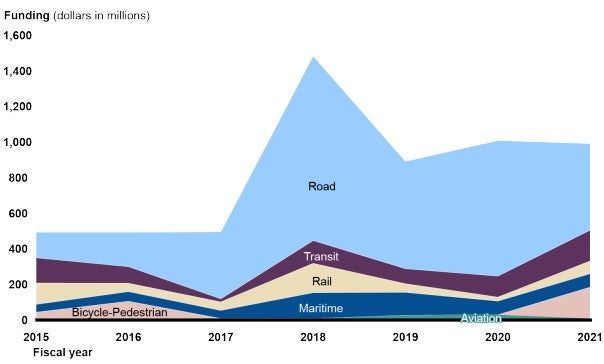As many as 21% of applicants for federal infrastructure grants — including states, cities and port authorities — could be overestimating how much they need to contribute to their projects due to poor communication from the U.S. Department of Transportation, according to a federal watchdog agency.
That lack of communication, as outlined in a report released Thursday by the Government Accountability Office (GAO), could mean applicants are having to dig for more money amid tight budgets or is discouraging them from applying for federal project grants altogether.
GAO’s assessment comes after the grant program in question — Rebuilding American Infrastructure with Sustainability and Equity (RAISE) — was appropriated $2.2 billion by Congress for fiscal year 2022, the most funding in a single year since the program began in 2009.

“Better communication from DOT on how it calculates the federal share for RAISE eligibility, and whether DOT will consider an application’s requested federal share in awarding grants, would improve transparency into DOT’s grant decisions,” according to GAO. “Such communication would also help applicants make informed decisions on how to allocate scarce non-federal resources while pursuing federal funding.”
Eligibility requirements of RAISE grants allow project sponsors at the state and local levels to obtain funding for multimodal, multijurisdictional projects that are more difficult to support through traditional DOT programs, according to DOT, with the money used for all types of freight projects aimed at speeding cargo through the supply chain.
For example, the most recent allocation of RAISE grants awarded in August funded 166 projects — including $25 million for a highway project that removes a freight bottleneck in Tucson, Arizona; $16 million to improve freight movement at PortMiami, Florida, and $10 million for a BNSF railroad grade separation in Oklahoma.
“RAISE can provide capital funding directly to any public entity, including municipalities, counties, port authorities, MPOs [metropolitan planning organizations] or others in contrast to traditional federal programs which provide funding to very specific groups of applicants (mostly state DOTs and transit agencies),” DOT states.
“This flexibility allows RAISE and our traditional partners at the state and local levels to work directly with a host of entities that own, operate, and maintain much of our transportation infrastructure, but otherwise cannot turn to the federal government for support.”
But that flexibility has been undercut, according to GAO, because DOT has not been fully transparent in explaining eligibility requirements in the Notice of Funding Opportunity (NOFO) issued when DOT begins accepting applications each year.
“Specifically, DOT did not state in its NOFOs [for FY2015 through 2021] that its calculation to verify an applicant’s eligibility with the federal share requirement did not include federal funding other than the RAISE request in an applicant’s project budget or the total project cost,” GAO stated.
The NOFOs issued by DOT for FY2019 through 2021 stated that the federal share of project costs for which a grant is awarded could not exceed 80% for urban projects, as set by Congress. “However, RAISE NOFOs for those years and prior years did not define federal share or how to calculate it, leaving applicants to determine whether the federal share included all federal funding sources or just RAISE funding,” according to the report.
GAO emphasized that leaving out calculation information means that applicants could be budgeting more nonfederal funding than necessary to meet federal share eligibility requirements.
“If applicants calculated their federal share based on the eligibility requirement as stated in the FAQs — including all federal funding and the total project cost — they could have assumed they needed more non-federal funding to meet the 80% federal share requirement than if they used DOT officials’ calculation method,” GAO stated.
“Our analysis of RAISE grant application data from fiscal year 2015 through 2021 found that about 21% of applications included other federal funding in their project budget.”
GAO recommended DOT enhance its procedures to ensure that its NOFOs explain how the RAISE grant federal share is calculated for eligibility purposes, as well as whether the amount of federal share requested by an applicant will be used as a criteria for awarding the grant.
DOT agreed with GAO’s recommendations and provided technical comments “which GAO incorporated as appropriate,” the report stated.







